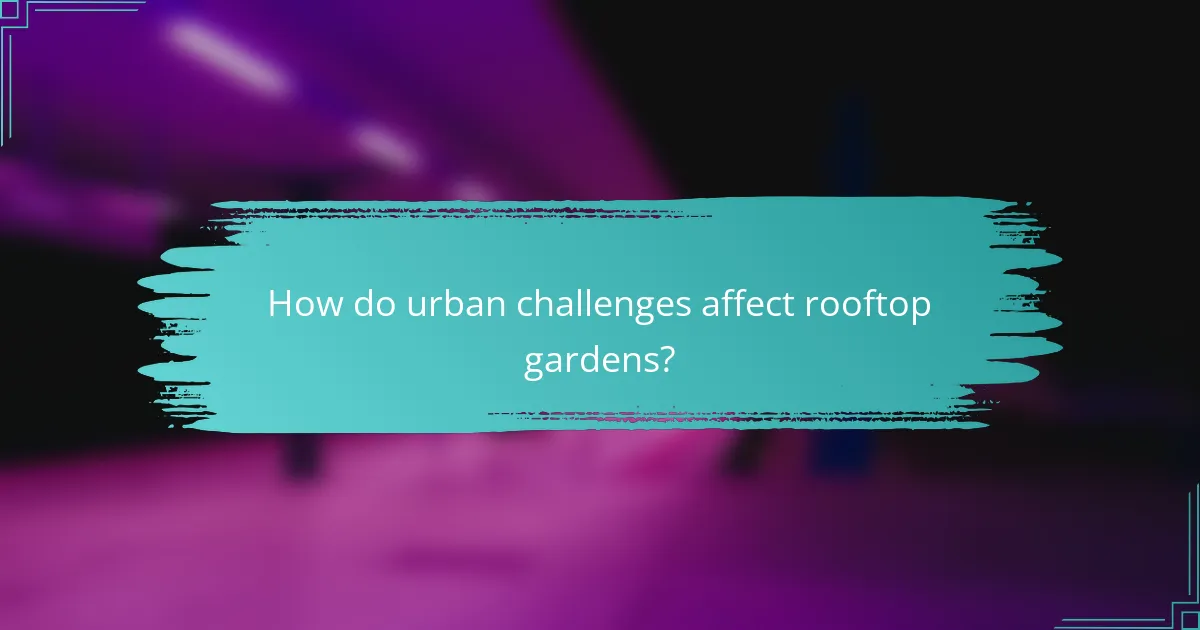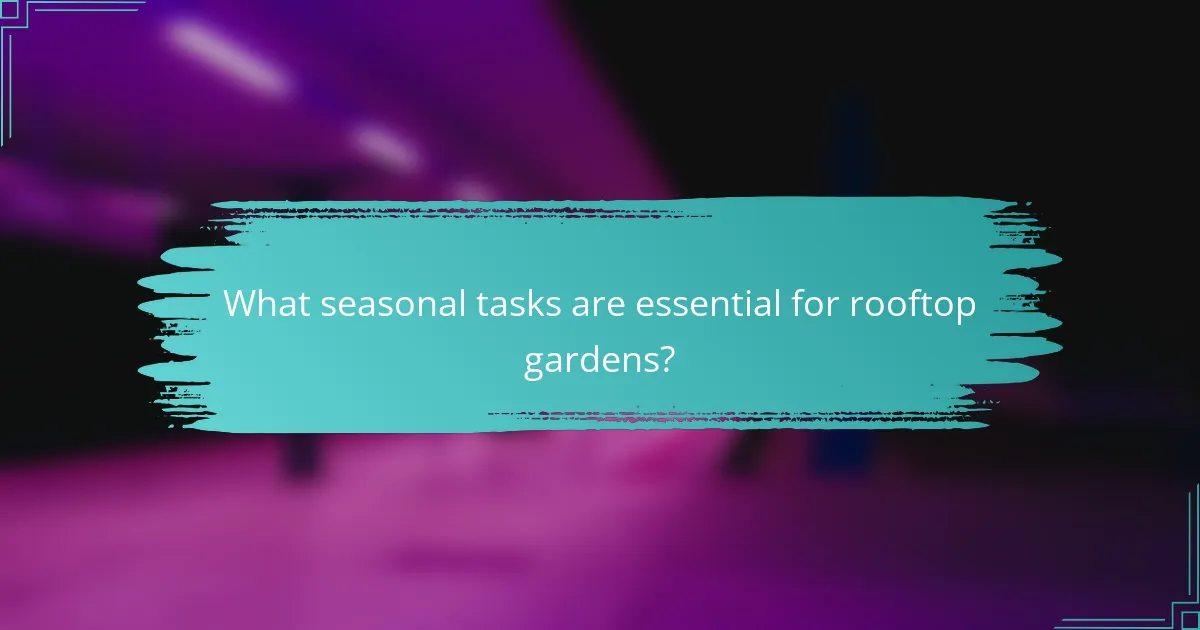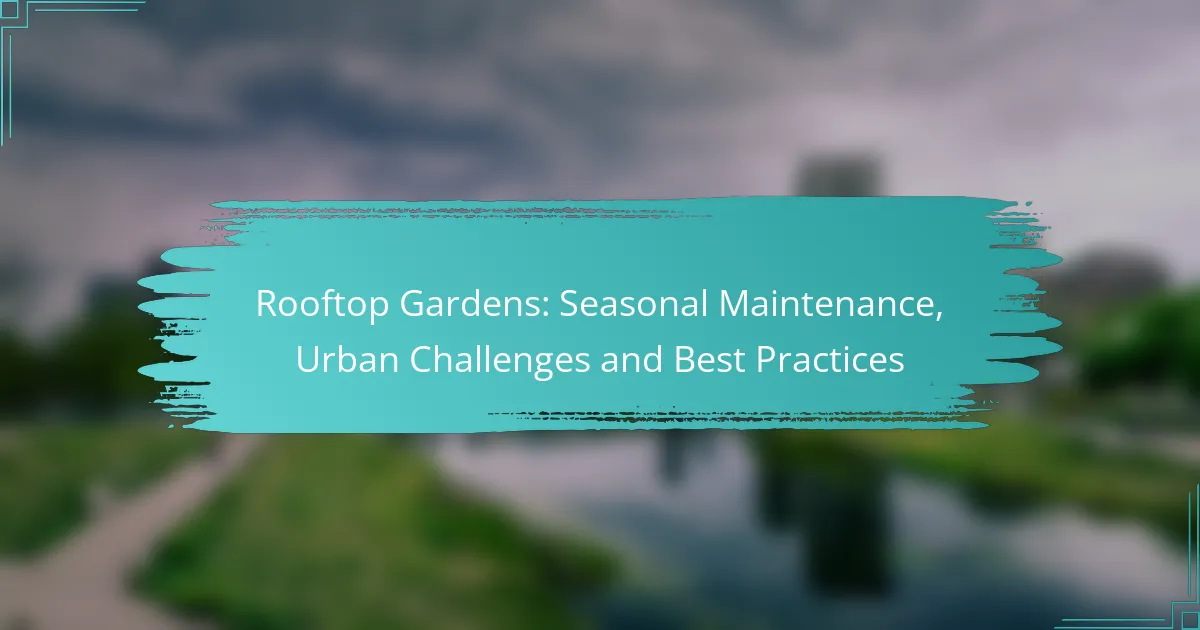Rooftop gardens offer a unique opportunity to enhance urban environments, but they require diligent seasonal maintenance and strategic planning to flourish. Addressing urban challenges such as limited space, air pollution, and temperature fluctuations is essential for sustaining healthy plant life. By implementing best practices and adapting to seasonal needs, gardeners can create vibrant green spaces that thrive amidst the complexities of city living.

What are the best practices for rooftop garden maintenance?
Effective rooftop garden maintenance involves regular care routines, appropriate plant choices, and proactive management strategies. Implementing best practices ensures a thriving garden that can withstand urban challenges.
Regular watering schedules
Establishing a consistent watering schedule is crucial for rooftop gardens, as they often experience rapid evaporation due to sun exposure and wind. Aim to water early in the morning or late in the evening to minimize water loss.
Consider using drip irrigation systems to deliver water directly to the roots, which conserves water and reduces the risk of fungal diseases. Monitor soil moisture levels regularly to adjust your watering frequency based on weather conditions.
Seasonal plant selection
Selecting the right plants for each season enhances the resilience and beauty of your rooftop garden. Choose drought-resistant and native species that can thrive in your local climate, which reduces maintenance needs.
In colder months, consider planting perennials that can withstand frost, while summer may be ideal for vibrant annuals. Rotate crops seasonally to maintain soil health and prevent pest buildup.
Soil health management
Maintaining healthy soil is vital for plant growth in rooftop gardens. Use a high-quality, lightweight soil mix that provides good drainage and aeration, which is essential for rooftop environments.
Regularly test soil pH and nutrient levels to ensure optimal conditions for your plants. Amend the soil with organic compost or mulch to improve fertility and moisture retention.
Pest control strategies
Implementing effective pest control strategies can protect your rooftop garden from infestations. Start with preventive measures, such as selecting pest-resistant plant varieties and maintaining plant health through proper care.
Use integrated pest management (IPM) techniques, which combine biological control, cultural practices, and, if necessary, organic pesticides. Regularly inspect plants for signs of pests and act quickly to mitigate any issues.
Fertilization techniques
Proper fertilization is essential for the growth of rooftop garden plants. Use slow-release fertilizers to provide a steady supply of nutrients over time, reducing the risk of nutrient runoff.
Apply fertilizers during the growing season, following the manufacturer’s instructions for dosage. Consider organic options like fish emulsion or seaweed extract, which can enhance soil health while minimizing environmental impact.

How do urban challenges affect rooftop gardens?
Urban challenges significantly impact rooftop gardens by limiting their growth potential and introducing environmental stressors. Factors such as limited space, air pollution, water drainage issues, and temperature fluctuations must be carefully managed to ensure healthy plants and sustainable practices.
Limited space for growth
Rooftop gardens often face constraints due to the limited space available for planting. This can restrict the variety and number of plants that can thrive, making it essential to choose species that are well-suited for confined areas. Vertical gardening techniques and container planting can help maximize the use of available space.
When planning a rooftop garden, consider using raised beds or modular systems that allow for efficient use of vertical space. This approach not only increases planting area but also enhances aesthetic appeal.
Air pollution impact
Air pollution can adversely affect rooftop gardens, as pollutants may hinder plant growth and reduce air quality. Plants can absorb some pollutants, but heavy exposure can lead to stress and decreased vitality. Selecting hardy plant species that are more tolerant of urban air quality can mitigate these effects.
Regular maintenance, including cleaning leaves to remove dust and pollutants, can help improve plant health. Additionally, incorporating air-purifying plants can enhance the overall environment of the rooftop garden.
Water drainage issues
Effective water drainage is crucial for rooftop gardens to prevent waterlogging and root rot. Urban rooftops may have inadequate drainage systems, leading to excess water accumulation. Installing proper drainage layers and using lightweight soil mixes can help facilitate better water management.
Consider integrating rainwater harvesting systems to utilize natural precipitation for irrigation. This not only addresses drainage issues but also promotes sustainability by reducing reliance on municipal water sources.
Temperature fluctuations
Temperature fluctuations in urban environments can create challenging conditions for rooftop gardens. Rooftops often experience higher temperatures due to the heat island effect, which can stress plants. Selecting heat-tolerant species and providing shade through structures or companion planting can help mitigate these temperature extremes.
Monitoring temperature and moisture levels is essential for maintaining plant health. Utilizing mulch can help regulate soil temperature and retain moisture, creating a more stable environment for growth.

What seasonal tasks are essential for rooftop gardens?
Seasonal tasks for rooftop gardens are crucial for maintaining plant health and maximizing yield. Each season presents unique challenges and opportunities, requiring specific actions to ensure the garden thrives throughout the year.
Spring planting preparations
In spring, it’s essential to prepare the rooftop garden for planting. Start by assessing the soil quality and adding organic matter like compost to enhance fertility. Choose plants that thrive in your climate, considering factors such as sunlight and wind exposure.
Before planting, clean the area by removing debris and weeds. This will help prevent pests and diseases. Plan your layout to optimize space and ensure proper air circulation among plants.
Summer irrigation practices
During the summer months, effective irrigation is vital due to increased heat and evaporation rates. Implement a drip irrigation system to deliver water directly to the roots, minimizing waste and reducing the risk of fungal diseases.
Monitor soil moisture regularly, aiming for consistent dampness without waterlogging. Consider mulching around plants to retain moisture and regulate soil temperature. Adjust your watering schedule based on rainfall and temperature fluctuations.
Fall harvesting techniques
In fall, it’s time to harvest your crops before the first frost. Identify which plants are ready for harvest by checking for size and color. Use sharp tools to avoid damaging the plants and ensure a clean cut.
After harvesting, clean up any remaining plant debris to prevent pests and diseases from overwintering. Store harvested produce properly to maintain freshness, and consider preserving excess crops through canning or freezing.
Winter protection measures
Winter poses significant challenges for rooftop gardens, requiring protective measures to safeguard plants. Insulate pots with materials like burlap or bubble wrap to prevent freezing of roots. Consider using row covers or frost blankets for added protection against harsh weather.
Reduce watering during winter, as plants enter dormancy. However, monitor for any signs of dehydration. If possible, relocate potted plants to a sheltered area to shield them from extreme cold and wind.

What tools are necessary for rooftop garden care?
Essential tools for rooftop garden care include hand tools for planting, irrigation systems, soil testing kits, and pest management equipment. Each category plays a vital role in maintaining a healthy and productive garden in an urban environment.
Hand tools for planting
Hand tools are crucial for planting and maintaining your rooftop garden. Basic tools such as trowels, pruners, and hand rakes are essential for digging, planting, and managing plants in confined spaces. Consider investing in lightweight, durable tools that are easy to handle and store.
When selecting hand tools, look for ergonomic designs to reduce strain during use. Tools with rust-resistant materials can also enhance longevity, especially in exposed rooftop conditions.
Irrigation systems
Irrigation systems are vital for ensuring your rooftop garden receives adequate water, especially in urban heat conditions. Drip irrigation is often the most efficient method, delivering water directly to the roots while minimizing evaporation. Consider a timer to automate watering schedules, which can help conserve water and ensure consistent moisture levels.
For smaller gardens, a simple soaker hose can be effective. Ensure that your system is compatible with your rooftop’s drainage capabilities to prevent water pooling, which can damage the structure.
Soil testing kits
Soil testing kits are important for assessing the nutrient levels and pH of your rooftop garden’s soil. These kits typically provide a straightforward process for collecting samples and analyzing them, helping you understand what amendments may be necessary for optimal plant growth. Regular testing can guide your fertilization and soil amendment strategies.
Look for kits that test for key nutrients such as nitrogen, phosphorus, and potassium, as well as pH levels. This information can help you tailor your soil management practices to the specific needs of your plants.
Pest management equipment
Pest management equipment is essential for protecting your rooftop garden from harmful insects and diseases. Basic tools include insect nets, traps, and organic pesticides that are safe for urban environments. Regular monitoring is key; inspect plants frequently for signs of pests or disease.
Consider integrating beneficial insects, such as ladybugs, which can help control pest populations naturally. Always follow local regulations regarding pesticide use to ensure compliance and safety in your urban setting.

How can rooftop gardens contribute to urban sustainability?
Rooftop gardens enhance urban sustainability by improving air quality, reducing heat, and promoting biodiversity. These green spaces help mitigate the environmental impact of cities, making them more livable and resilient.
Improved air quality
Rooftop gardens play a significant role in enhancing air quality in urban areas. They absorb carbon dioxide and release oxygen, which can help reduce pollution levels. Additionally, plants filter airborne particulates, contributing to cleaner air.
To maximize air quality benefits, select a variety of plants that are known for their air-purifying properties. Species such as ferns, spider plants, and peace lilies are effective choices. Regular maintenance, including watering and pruning, ensures these plants thrive and continue to filter pollutants effectively.
Be mindful of local regulations regarding rooftop gardens, as some cities may have specific guidelines for plant selection and maintenance. Engaging with local environmental groups can provide additional resources and support for establishing a successful rooftop garden that improves air quality.
